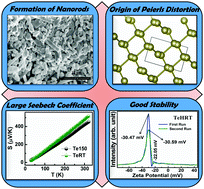Peierls distortion, large Seebeck coefficient, and dispersibility of green solution phase synthesized tellurium nanoparticles†
Abstract
Tellurium (Te) is an appealing material for thermoelectric and many other applications due to its layered structures and highly anisotropic nature. We synthesized Te nanoparticles (NPs) using a facile, efficient, and green solution-phase polyol method using two different precursors at room temperature (RT) and 150 °C, and proposed their formation mechanism. X-ray diffraction (XRD), field emission scanning electron microscopy (FESEM), transmission electron microscopy (TEM), Raman spectroscopy, dynamic light scattering (DLS), and Seebeck coefficients have been used to characterized these NPs. Raman spectra signify the hexagonal Te modes of vibrations and no expected impurities. FESEM and TEM images show the formation of nanorods and other nanoparticles (NPs). They show enhanced Seebeck coefficients, Peierls distortion, and dispersibility in deionized water (DIW); samples prepared at RT show better stability than others do. A positive Seebeck coefficient (S) for all the samples indicates their p-type semiconducting behavior; the S value of 517 μV K−1 for the sample synthesized at RT shows nearly 16% enhancement compared to that synthesized at 150 °C. We have discussed their details.



 Please wait while we load your content...
Please wait while we load your content...